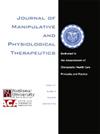有和无单侧腰神经根压迫影像学证据者自我报告的功能测量与下肢运动表现的比较:横断面研究
IF 1.4
4区 医学
Q4 HEALTH CARE SCIENCES & SERVICES
Journal of Manipulative and Physiological Therapeutics
Pub Date : 2023-05-01
DOI:10.1016/j.jmpt.2024.02.002
引用次数: 0
摘要
研究目的本研究的主要目的是确定单侧腰神经根压迫(ULNRC)的影像学检查结果是否会影响协调运动表现任务的成绩,并确定运动成绩与自我报告的临床指标之间是否存在相关性:根据腰椎影像学检查和临床表现(ULNRC)将腰痛患者(45 人)分为 3 组。第一组包括影像学显示腰椎神经根受压并伴有神经功能缺损的患者。第 2 组患者的影像学表现为神经受压,但无运动、感觉或反射变化。第 3 组参与者在腰椎成像片上仅有退行性病变,但神经功能完好。表现测量包括行为和运动学变量,这些变量来自于一项既定的下肢菲茨任务,要求对不同难度的目标进行运动。此外,还收集了有关残疾、功能和疼痛的自我报告指标。对组间和组内变量进行了方差分析,并对表现与自我报告的测量结果进行了皮尔逊相关性比较:正如菲茨定律所预测的那样,随着任务难度的增加,所有组别在运动时间上都产生了主效应。主效应显示,第一组参与者的表现不如第三组参与者准确。第 2 组和第 3 组的自我报告测量与运动表现之间主要呈正相关:结论:影像和自我报告测量结果本身并不能预测功能,但是,菲茨任务表现的准确性却能有效区分不同组别。本文章由计算机程序翻译,如有差异,请以英文原文为准。
Self-reported Measures of Function Compared to Lower Limb Motor Performance in People With and Without Imaging Evidence of Unilateral Lumbar Nerve Root Compression: A Cross-sectional Study
Objective
The primary objective of the present study was to determine if imaging findings of unilateral lumbar nerve root compression (ULNRC) impact performance on a coordinated motor performance task and to determine if there were correlations between motor performance and self-reported clinical measures.
Methods
People with back pain (N = 45) were stratified into 3 groups based on combinations of: lumbar imaging; and clinical presentation for ULNRC. Group 1 included people with imaging of lumbar nerve root compression, who presented with neurological deficit. Group 2 people demonstrated imaging evidence of nerve compression, without motor, sensory or reflex change. Group 3 participants possessed only degenerative changes on lumbar imaging films, and were neurologically intact. Performance measures included behavioral and kinematic variables from an established lower limb Fitts’ Task requiring movements to targets of different difficulties. Self-reported measures of disability, function and pain were collected. Analysis of variance for between and within group variables were conducted, and Pearson correlation compared performance with self-reported measures.
Results
All groups yielded main effects for movement time with increasing task difficulty as predicted by Fitts’ Law. A main effect revealed Group 1 participants performed less accurately than Group 3 participants. Positive correlations were predominantly found between self-report measures and motor performance for Group 2 and Group 3.
Conclusion
Imaging, and self-reported measures alone did not predict function, however, Fitts’ task performance accuracy effectively differentiated groups.
求助全文
通过发布文献求助,成功后即可免费获取论文全文。
去求助
来源期刊
CiteScore
3.00
自引率
7.70%
发文量
63
审稿时长
29 weeks
期刊介绍:
The Journal of Manipulative and Physiological Therapeutics (JMPT) is an international and interdisciplinary journal dedicated to the advancement of conservative health care principles and practices. The JMPT is the premier biomedical publication in the chiropractic profession and publishes peer reviewed, research articles and the Journal''s editorial board includes leading researchers from around the world.
The Journal publishes original primary research and review articles of the highest quality in relevant topic areas. The JMPT addresses practitioners and researchers needs by adding to their clinical and basic science knowledge and by informing them about relevant issues that influence health care practices.

 求助内容:
求助内容: 应助结果提醒方式:
应助结果提醒方式:


